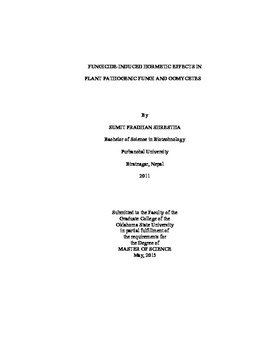| dc.contributor.advisor | Garzon, Carla | |
| dc.contributor.author | Pradhan Shrestha, Sumit | |
| dc.date.accessioned | 2016-09-29T18:36:29Z | |
| dc.date.available | 2016-09-29T18:36:29Z | |
| dc.date.issued | 2015-05-01 | |
| dc.identifier.uri | https://hdl.handle.net/11244/45199 | |
| dc.description.abstract | Fungi and Oomycetes pathogens are the causal agents of several plant diseases that often require chemical control. Fungicides are one of the main components in the management of such diseases. Intensive use of few fungicide active ingredients with the same mode of action without rotation result in selection of resistant isolates. Previous dose-response studies have reported increased growth, virulence and mycotoxin production in such resistant isolates when exposed to low doses of fungicides. Non-target effects of sublethal doses of fungicide, which can trigger beneficial responses in fungal and oomycete pathogens, can be attributed to �fungicide hormesis�. Although fungicide hormesis is often misinterpreted as experimental error and is overlooked, it is a highly reproducible phenomenon and can be well characterized by using proper experimental design and statistical tools. The objective of this study was to study the quantitative feature of fungicide hormesis. The first objective determined fungicide hormesis to be significant among resistant Pythium species: P. irregulare and P. ultimum. Two assays considering mycelial growth as endpoint were developed for this purpose. We found significant stimulation in growth area and total dry weight in both species at sublethal doses of mefenoxam. The second objective studied ubiquitous occurrence of fungicide hormesis among population of resistant isolates within Sclerotinia homoeocarpa. Twenty eight isolates of S. homoeocarpa were used to assess fungicide hormesis at subinhibitory doses of thiophanate-methyl. After multiple cycles of exposure to low doses of thiophanate-methyl, 17 isolates were determined to be thiophanate-methyl resistant, of which 81% showed statistically significant growth stimulation (2.8-19.7%). These observations reflected a high frequency of fungicide hormesis among resistant isolates of S. homoeocarpa. Overall, our results support the hypothesis that fungicide hormesis is common among fungal and oomycete plant pathogens. In vivo studies based on field and greenhouse trials are needed to assess the impact of fungicide hormesis on plant health. Nonetheless, it is recommended that chemical hormesis should be considered and properly assessed as a part of disease management strategies. | |
| dc.format | application/pdf | |
| dc.language | en_US | |
| dc.rights | Copyright is held by the author who has granted the Oklahoma State University Library the non-exclusive right to share this material in its institutional repository. Contact Digital Library Services at lib-dls@okstate.edu or 405-744-9161 for the permission policy on the use, reproduction or distribution of this material. | |
| dc.title | Fungicide-induced Hormetic Effects in Plant Pathogenic Fungi and Oomycetes | |
| dc.type | text | |
| dc.contributor.committeeMember | Walker, Nathan | |
| dc.contributor.committeeMember | Melouk, Hassan | |
| osu.filename | PRADHANSHRESTHA_okstate_0664M_14041.pdf | |
| osu.accesstype | Open Access | |
| dc.description.department | Plant Pathology (PhD) | |
| dc.type.genre | Thesis | |
